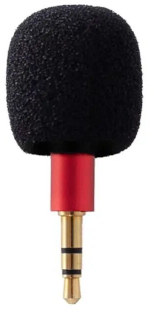- Sampler
- Adding samples via Wooveconnect
- Sampling sounds from the audio input
- Re-sampling the internal synthesizer
- Vocoder
- Working with slices
- Auto-slicing
- Real-time pitch and time warping
- Amen chop tutorial
- Multi-sampled instruments
- Using samples and kits in your songs
- Using single-cycle AKWF samples
- Using Amiga Tracker samples
- Using Teenage Engineering OP-1 / OP-Z sample kits
- Backing up sample kits
- Auto-space reclaimer
- Limitations
- Sampling sounds from the audio input
- Line level vs mic level
Recording line level vs mic level

Ideally, the audio source should output "line level" (a smartphone, table, laptop, keyboard, the audio output of any other synthesizer gear, etc.). However, if you are in a pinch and need to record voice for further processing, your Woovebox can also record faint "mic level" signals as produced by cheap unamplified microphones directly plugged into the input.
To record mic level, in the sampler, hold write and play, then turn the value knob right (for mic level) or left (for line level - default). Please note that trying to record faint mic level signals without switching the input to "Mic LEvL", will result in interference being audible in your recording.
Mic level signal amplification and filtering is performed in the digital domain; a custom-designed digital filtering algorithm removes the interference after recording a slice. As a result, a short pause (dependent on the length of the sample) occurs after recording the sample. You will also notice all LEDs turn off during recording of mic-level sources; all unnecessary sub-systems are powered down to minimize noise and interference.
Sampling mic-level input is mostly meant for getting voice recording/input on the device for further processing (for example via the vocoder, or using the voice recordings as material for pitch and time warping). You may find it less suited for recording ambient or non-voice sounds. A fixed 300Hz - 8000Hz bandpass filter is in place to remove non-voice related frequencies and rumble.
You will typically find it is necessary to speak closely to the mic, almost touching the pop shield - much like a pro-singer of voiceover artist - to get the cleanest possible recording. The less the signal has to be amplified, the less noise will be present in the recording.
Lastly, make sure your chosen mic is able (or TRS fixed-wired) to provide a stereo signal (e.g. has its signal on both the Tip and Ring).
You may also be interested in...
- 3. O3.Lv Oscillator 3 Level (under Pitch page)
Values prefixed by o1 indicate oscillator 3 should adopt the pitch and amplitude modulation (envelope generators, LFOs, etc.) of oscillator 1.
- Advanced modes and techniques (under Using samples and kits in your songs)
- Glob (song globals) page (under Song-wide settings)
- Gating by a dedicated gate track (under Example)
- Gating off (under Example)
- Sampler
- Adding samples via Wooveconnect
- Sampling sounds from the audio input
- Re-sampling the internal synthesizer
- Vocoder
- Working with slices
- Auto-slicing
- Real-time pitch and time warping
- Amen chop tutorial
- Multi-sampled instruments
- Using samples and kits in your songs
- Using single-cycle AKWF samples
- Using Amiga Tracker samples
- Using Teenage Engineering OP-1 / OP-Z sample kits
- Backing up sample kits
- Auto-space reclaimer
- Limitations